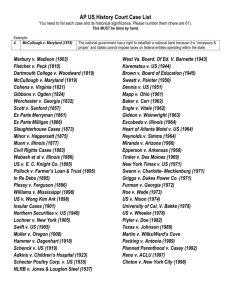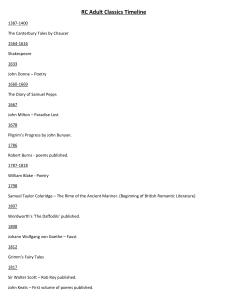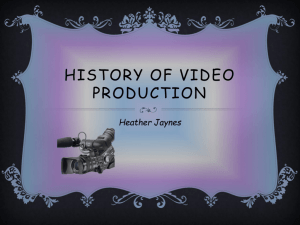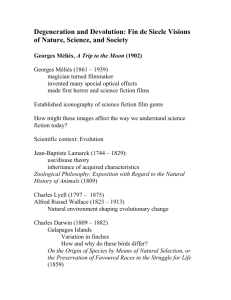Jumpstarting a 105 Year-Old Community Icon
advertisement
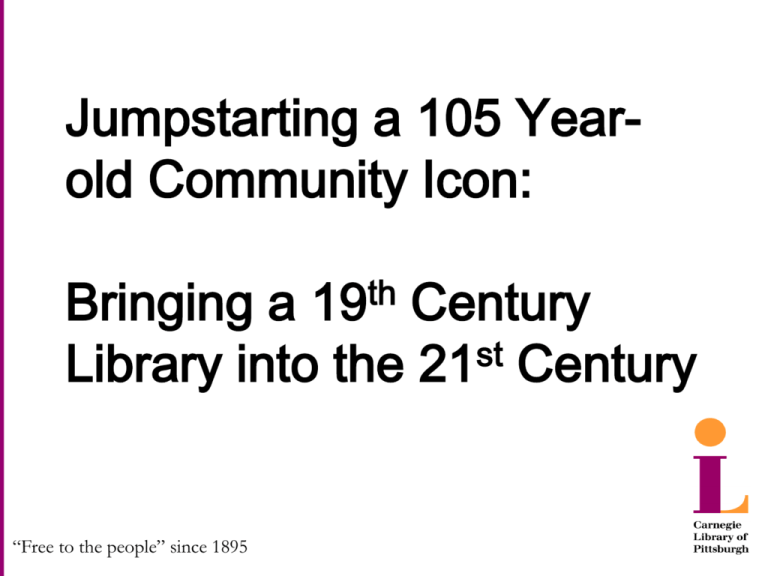
Jumpstarting a 105 Yearold Community Icon: Bringing a 19th Century st Library into the 21 Century “Free to the people” since 1895 a presentation to PLA Annual Conference Minneapolis March 2008 “Free to the people” since 1895 Your Presenters Richard Kaplan Manager, Reference Services Carnegie Library of Pittsburgh – Main kaplanr@carnegielibrary.org Karen Rossi Manager Carnegie Library of Pittsburgh – Downtown & Business rossik@carnegielibrary.org “Free to the people” since 1895 Carnegie Library of Pittsburgh “Free to the people” since 1895 Why did we embark on this project? “Free to the people” since 1895 Examining the role of public library Impact of Internet? Impact of amazon.com and super bookstores? Effect of rise in service economy on customers’ expectations? Implication of the decrease in free time and increase in discretionary income (for some)? Relevance of the academic model of subjectspecific departments for the public library? “Free to the people” since 1895 Goals of library redesign Created library that is customer-centered and user-friendly • • Eliminate customer frustration Arrange activities and key spaces Increase user base Deliver information needs to users Make library a destination in the community “Free to the people” since 1895 Outcome of Strategic Planning: Our challenge Transformed space and services • Designed and created a popular destination within a traditional library • Merged subject departments into a cohesive Reference Department • Trained and mentored staff to focus on excellent service to customers “Free to the people” since 1895 Capital projects We embarked on our renovation projects • 4 architects, 7 locations and more to come! • Distinct neighborhoods, distinct libraries Website redesign Concerned that communication with the public would become more fragmented and unplanned unless we created a consistent conceptual framework that would both inform and be layered on top of the new physical architecture • Information Architecture informed the process. “Free to the people” since 1895 Information Architecture? “Free to the people” since 1895 taming complexity TM An information architecture gives you predictability (it’s one of the ways we make things easier to use…) User Interface “Free to the people” since 1895 Information Architecture System Architecture Example: McDonald’s Infrastructure: the building, the cooking equipment, the pricing structure, what times of day you can get an Egg McMuffin vs. a Big Mac, etc. user interface: the signs and the design of the customer-facing portions of the infrastructure. information architecture: the mental model that most people share for “how to interact with a fast food restaurant”. Includes the concepts of: • a menu with items and their prices (only shows what you can order at that time, or lists the times) • a place where promotions are displayed • a sequence of events that are followed in a particular order • an area in which to place an order, pay for the order, pick up the order • an area in which to eat the food • a place to discard the garbage “Free to the people” since 1895 Libraries as complex organizations Variety of customer needs Variety of services Variety of materials Variety of facility issues Depth of resources “Free to the people” since 1895 Organizers make connections “Free to>the people” since 1895 Overview Research > Analysis > Design The end of every customer journey should be the beginning of a new one “Free to>the people” since 1895 Overview Research > Analysis > Design How do we serve the 21st century library user? “Free to the people” since 1895 What do we want people to think when they walk in our doors? “Free to the people” since 1895 How can we optimize our space, services and collections? “Free to the people” since 1895 “Free to the people” since 1895 Outdoor space “Free to the people” since 1895 Quiet Reading Room “Free to the people” since 1895 r a m m i n g Large print room “Free to the people” since 1895 The Gallery @ Main “Free to the people” since 1895 “Free to the people” since 1895 Teen “Free to the people” since 1895 “Free to the people” since 1895 “Free to the people” since 1895 “Free to the people” since 1895 “Free to the people” since 1895 Results? Named Number One “Most Useful Web Site” in Pittsburgh by Pittsburgh Magazine in 2004 4.1 million visits in 2004 5.9 million visits in 2007 “Free to the people” since 1895 Always ask myself: What do I hope people will say about this library? This staff? How can we optimize our space, services & collections? “Free to the people” since 1895 What are we committed to? What do we want to accomplish as we work together? “Free to the people” since 1895 Staff selection Qualities / characteristics Hire for attitude Teach skills “Free to the people” since 1895 Hiring process General announcement and invitation • • All-staff newsletter Internal job posting Information sessions “Free to the people” since 1895 Hiring process Letter of interest Meet & Greets Interviews “Free to the people” since 1895 Sample interview questions What’s the best customer service transaction you’ve ever experienced (in any environment)? What would you do to change the traditional perception of the library to become a more vibrant place to visit? “Free to the people” since 1895 Don’t ask, “What if it doesn’t work?” Instead, ask, “How will I feel if I don’t even try?” - Suzanne Zoglio “Free to the people” since 1895 Staff training and development To learn and master skill sets Challenge staff to explore and develop fresh, new ideas • Expectation: explosion of ideas Brainstorm Encourage new approaches to library services • How can we do it better? • More effectively? • Imaginative & innovative Take risks “Free to the people” since 1895 Staff training and development Customer service / best practices Booklists, book reviews Book discussion groups Collection development basics Understanding our Goals & Objectives Databases Program planning and implementation Readers’ Advisory skills Reference interview “Free to the people” since 1895 Ongoing staff training Reader’s Advisory workshops • Staff lead training workshops • Mysteries, urban lit, romance, chick lit • Overview of bestselling authors, subgenres, • award winners CLP staff and librarians throughout the county consortium attended “Free to the people” since 1895 Ongoing staff training At staff meetings • • Best Practices Roundtables Enhance book-talking skills • • • • Genre-of-the-month readings Discuss what we’re reading in the genre Brainstorm read-alikes Constant practice “Free to the people” since 1895 What fascinates you? What makes your heart sing? “Free to the people” since 1895 Staff involvement We’re creating a unique atmosphere, even a spirit. We’re identifying 21st Century customer service expectations. We’re creating a new type of teamwork for managers and staff. Our staff have new opportunities to work together. “Free to the people” since 1895 Our challenge Transformed space and services • Designed and created a popular destination within a traditional library • Merged subject departments into a cohesive Reference Department • Trained and mentored staff to focus on excellent service to customers “Free to the people” since 1895 Carnegie Library of Pittsburgh 4 5 • Opened November 5, 1895 • The Library's first annual report, January 31, 1897. • • • • A staff of nineteen; A book collection of 27,000 volumes; A City appropriation of $65,000; and Cash in hand for the erection of seven branch buildings. • 1898 Children’s Department opened. • 1898 & 1899 Andrew Carnegie gives two $10,000 gifts for technical periodicals and the journals of learned societies. • 1902 Science & Technology Department established. (Believed to be the oldest such Dept. in a US public library. • 1902 Patent Depository established. • 1905 Government Document depository status. • 2005 3 million items, 96 staff. “Free to the people” since 1895 4 6 Around the mid 1970s Between 1996 & 2001 “Free to the people” since 1895 4 7 Around the mid 1970s Between 1996 & 2001 “Free to the people” since 1895 Background • 1998 -- Application of business planning model to public library operations. • Process begun for strategic planning and goal setting. • Staff, customer and consultant research / input to determine future directions. • 2000-2001 -- System wide strategic planning process initiated. • • • • Services Facilities Training Collections • Existing research service model with subject departments, last altered in 1986. • Do existing services meet current & projected user demands and needs? • Does the facility support the needed service requirements? “Free to the people” since 1895 4 8 8 Subject Departments 1. Children's Dept. 2. Foundation Center 3. Humanities 4. 5. 6. 7. 8. (AV, Fiction, Literature, Poetry, Religion, Philosophy, Sports, Entertainment.) Job, Career & Education. Music & Art Dept. Pennsylvania Dept. (Local History, Pennsylvaniana, Genealogy.) Science & Technology (Sciences, Medicine & Health, Patents, Cookbooks, Psychology, & Gov Docs.) Social Sciences (History, Politics, Law, Business, Geography, Sociology, & Gov Docs.) “Free to the people” since 1895 4 9 • LC shelving organized by department floor. • • • • • 1st floor - Humanities. B-BD, BH-BX, GV, P-PZ & Fiction. 2nd floor – Social Sciences. A, C-CN, CR-CT, D-L & Z. 2nd floor – Music & Art. M-N. 3rd floor – Science & Technology. Q-V, circulating Dewey. 8 “stacks” of Reference materials NOT browsable. • User Focus Group Conclusions. • Confusing “jargon”. We use terminology not used / understood by public library user. • Unnecessary multiple trips to find information and materials. • AV (then 25% of all circulation) too decentralized and spread out. • Conclusion / recommendation adopted, Fall 2002: • Provide an Integrated Service Delivery Model. “Free to the people” since 1895 5 0 What is an Integrated Service Delivery Model? • A consolidation of the major subject discipline depts. • Redistribution of the reference and circulating non-fiction • collections into sequential call number order. Transfer of almost all pre-1970 periodicals and the library’s Heritage Collections to off-site depository and allow for 5 years of growth in the circulating and reference stack areas. What are the benefits? • Less customer / user confusion. • Single point of service for reference. (excl. PA and Jobs.) • Reduction in overall staff costs. • Services and collections that more accurately reflect library • use. Enhance the value of the professional staff by providing training and experience that broadens their depth of knowledge. “Free to the people” since 1895 5 1 Main Library Service Points Then Existing Model for Main Library • • • • • • • • Children's Dept. Foundation Center Humanities Job, Career & Education. Music & Art Dept. Pennsylvania Dept. Science & Technology Social Sciences Planned Model for Main Library • • • • • • Children's Dept. Film & Audio – New. New & Featured – New. Job, Career & Education. Pennsylvania Dept. Combined Reference The Foundation Center moved to CLP’s Downtown & Business Library in 2001. “Free to the people” since 1895 5 2 How to Implement the Program? • Summer, 2002 - Selected a Manager to coordinate the subject department merger, who became the Dept. Head. • Developed a timeline to merge the departments and services based on renovation and collection shifting program at Main Library. • Transferred of all Services affected by construction schedule on library’s first floor. Humanities, Job Center and Customer Services (check-in, check-out, returns and library cards) • Shifted of over 1,000,000 volumes (+500,000 non print items) on 11 floors or stacks into call number order. • Opened up an additional floor for public browsing, and transferred pre-1970 periodicals and duplicate reference materials to off-site depository (100,000 items.) • Weeded, cleaned up and transferred another 50,000 items from “old” warehouse to depository. • Weeded over 150,000 items from Main Library collections. “Free to the people” since 1895 5 3 Carnegie Library of Pittsburgh Main Library floor profile Open Stack 3 Open Stack 2 Open Stack (new) Open Stack 1 Offices, shipping, admin. “Free to the people” since 1895 54 At the same time we: 1. 2. 3. 4. 5. 6. 7. Developed a plan for the new First Floor configuration Setup a new Film & Audio Dept. Reconfigured our Photocopy & Microfilm Services • • Photocopy previously reported to Science & Technology Microfilm previously reported to Social Sciences. Maintained all of our services during renovation. Accommodated users from nearby Squirrel Hill Branch closed for renovations. (Single busiest neighborhood location after Main Library.) Re-opened two branches that completed renovations. Eliminated 13 positions system-wide due to state funding cuts. (The blow was softened by having 11 concurrent vacancies in Main Library.) “Free to the people” since 1895 55 The Process Examined Carnegie Library subject departments and other urban libraries that had merged or consolidated departments. • • • • • • • • • Began a regular round of information meetings with all of Main Library staff to keep them informed of developments, invite suggestions, and promote staff buy-in. Reviewed Collections. Reviewed Budget allocations. Reviewed Periodical & Serial acquisitions. • Substantial duplication of tools and standard titles between depts. Looked at outside collaborative efforts. Examined Information & Vertical Files. (3/4 were discarded.) Assessed skill requirements in different disciplines. Discovered idiosyncratic ways of each department. Asked what other libraries had done. “Free to the people” since 1895 56 Prior to Renovations. • Established a schedule and scope of cross-training to be developed and conducted by Main Library staff. • The staff needed to learn and develop the practical skills outside their traditional areas. • Makes them an integral part of the process. • They’re making it happen, it’s not being done to them. • Determined an order to integrate the departments. • Decision was made based on our intuition, and observations of outside libraries that it needs to be a graduated process. • Complete individual departments in a deliberate fashion. • Merge the staff and the collections together, with particular attention paid to what the incoming staff feel are their important reference resources. “Free to the people” since 1895 57 58 • Concurrent with cross-training, began a cycle of cross-staffing in the existing departments. • Exposed staff to resources and patrons they’re not familiar with. • Better acquaint them with their professional colleagues and future co-workers. • Better acquaint them with their “new” patrons. • Increase and promote all-around comfort levels. “Free to the people” since 1895 Cross Training (39 sessions between February & June, 2003) • February 2003. • What is a general overview? • • • • • Humanities Dept. general overview. Music & Art Dept. general overview Social Sciences Dept. general overview. Science & Technology Dept. general overview. Teens general overview. • Nature and scope of the dept’s. collection and service areas. • Nature of the most common inquiries and questions asked. • Most common and useful reference resources utilized. • Which staff have subject expertise. “Free to the people” since 1895 59 Cross Training - Workshops • Humanities Workshops. • Readers Advisory • Literature – American – British – World • • • • • • • • Literary Criticism African American Literary Resources Shakespeare Resources Finding poems and short stories. Religion & Theology Resources. Authorsheets (Carnegie Library developed literature resource) Using Explicators Concordances “Free to the people” since 1895 60 Cross Training - Workshops • Music & Art.* • • • • • • • • • • Art & Artists. Architecture. Appraisals and Auction Prices. Collectibles. Pittsburgh Artists and Architecture. Music – Searching Uniform Titles in the catalog. Musicians, variations on names and non-English use. Pittsburgh Musicians. Special collections within the Music & Art Dept. Music Scores & Sheet Music. * In late 2005, we decided to keep Music itself as a separate department sharing common functions and space with the Film & Audio Dept. “Free to the people” since 1895 61 Cross Training - Workshops • Social Sciences Dept. • ERIC and other resources in education. • History sets. • Finding statistical data – Governmental – International • Business information – Directory – Financial data • Consumer information • Copyright • Government Documents. – Introduction – Finding Aids – Formats “Free to the people” since 1895 62 Cross Training - Workshops • Science & Technology Dept. • Science Handbooks – (Chemistry, Physics, etc.) • Science Fair Projects • Manufacturer’s Directories – Duns – Thomas’ Registers • Army & Navy Registers • Medline • Patents – US – British • Trademarks “Free to the people” since 1895 63 Cross Training - Workshops • Science & Technology • Standards (CLP maintains a significant collection.) – ANSI – ASTM – British & ISO – MILSPEC • Building & Construction Codes. – BOCA – National Fire Safety Code – RS Means • Topographical Maps & Mapping. • Used Car Prices. • Government Documents. • NASA & SAE Technical Reports (Fiche.) “Free to the people” since 1895 64 Cross Training Workshops • Unique Construct. Half of the classes designed by the subject departments. • The 2nd half were planned based on feedback and requests from the librarians themselves. • Based on their experiences during cross-staffing exchanges. • Based on questions colleagues were asking the subject librarians. • Cross Training was continual, gradually becoming an internal continuing education tool. We still do them. • • • • • Once or twice a month. Informal. Staff driven and staff taught. No more than 1 hour. Content, topic, or database specific. “Free to the people” since 1895 65 Timeline 2003 • Planned & scheduled cross-training / cross-staffing. • Initiated deliberate cross training programs and cross-staffing. • Continued through June. • First floor of the library closes for renovations (excluding the Children’s Dept.) • Humanities Dept. shares space and staffing with Social Sciences Dept. but is maintained as a separate administrative unit. (Not fully merged yet.) • Late 2003 -- Humanities and Social Sciences Depts. officially become the first two components of the new Reference Services Dept. “Free to the people” since 1895 66 Timeline 67 2004 • Continued cross-staffing with Science & Technology and Music & Art Depts. • Late 2004 -- moved the resources and staff of Science & Technology Dept. to the 2nd floor and merged them into Reference Services. 2005 • Reassigned Art Librarian to Reference Services. Maintain split schedule with Music & Art Dept until December while new Film & Audio Dept., coordinated with Music librarians. 2006 • All intended subject departments merged into Reference Services. “Free to the people” since 1895 Reality Check – November 2004 • Reference Question Survey – Two weeks. • Tracked every reference question asked (excl. directional.) • Confirmed the premise behind the consolidation of the subject departments. • Tracked where the users are from. • Tracked who they are. – Students – Business community – Regular library user or not? • What resources were used? • Expertise level required to answer the question. “Free to the people” since 1895 68 Reference Question User Survey “Free to the people” since 1895 69 Survey Results 70 Ref Services Questions Humanities & Soc. Sci. Social Sciences / Humanities 2050 Questions • • • • • 20% - History 20% - Literary Criticism 15% - Business related. 15% - “What is…?” 30% - Mixed “Free to the people” since 1895 Current Events 5% Religion 6% What is? 13% Books 6% Census & Geog. 5% Lit Crit 18% Law & Gov 7% Articles 8% Business 13% History 19% Survey Results Social Sciences / Humanities Users • 50% - Personal • 40% - Students • • 50% - College & University • 45% - Secondary • 5% - Elementary 10% - Business Users. “Free to the people” since 1895 71 72 Survey Results Science & Technology Sci Tech Questions 1970 Questions. • • • • • 45% - General 20% - Common Science & Health 15% - Patents & Trademarks. 10% - “How do I…?” 10% - Hard Sciences. Common Sciences 21% General 43% Hard Sciences 8% Patents 15% How do I 13% “Free to the people” since 1895 Survey Results Science & Technology Users • • • 45% - Personal 40% - Students • 65% - College & University • 30% - Secondary • 5% - Elementary 15% - Business Users. “Free to the people” since 1895 73 74 Survey Results Music & Art Music & Art Questions 1230 Questions • 30% - Hard Music • 25% - Music Scores • 15% - Hard Art • 15% - General Music • 15% - Mixed • Lyrics • Collectibles • Images “Free to the people” since 1895 Hard Art 17% Music 13% Collectibles 6% Images 3% Lyrics 7% Hard Music 28% Scores 26% Survey Results Music & Art Users • • • 60% - Personal 25% - Students • 65% - College & University • 30% - Secondary • 5% - Elementary 15% - Business Users. • Auction Houses • Attorneys • Appraisers “Free to the people” since 1895 75 Survey Conclusions: 1. Decision to consolidate subject departments was correct. 2. Revisited the decision as related to the Music component of Music & Art. 3. Academic users are a substantial portion of the library’s active customer base. • • Service implications Technology implications 4. With the exception of Music, specific discipline expertise isn’t necessary to meet the majority of user demand most of the time. - “Can I have your number, we’ll call back with that answer.” “Free to the people” since 1895 76 Conclusions & Recommendations 1. Allow as much time as possible / feasible to plan, promote (staff & public buy-in) and train for a subject department consolidation. 2. Use graduated cross-staffing to familiarize staff with their colleagues, the resources they’ll need to use, and the patrons or customers they’ll need to serve. 3. Encourage and support staff planning of thorough crosstraining. 1. 2. 3. 4. 5. Learn the resources. Learn the questions. Meet your colleagues. Reduce the stress factor. Involve the staff at all levels and solicit their input. “Free to the people” since 1895 77 Conclusions & Recommendations 4. Use your construction delays wisely. Communicate Communicate & Communicate. “Free to the people” since 1895 78 Reference Services Customer Service Model • • • • • • 79 As much as possible separate phone service from desk or walk-up service. Substitute some standing orders for on-demand purchases. • ANSI Standards Provide electronic document delivery, including original PDFs. Plain language signage – say it in English. Balance what users use / need and anticipated use vs. acquiring materials because you’ve always bought them. Use data to make your decisions. • Survey results • Usage • ILL and photocopy requests. “Free to the people” since 1895 Results of the redesign? Visitors up 93% • • Squirrel Hill Library Since 2002 Visitors up 67% • Downtown & Business Library • Since 2002 Circulation up 42% • Hazelwood Library • Since reopening in May 2004 “Free to the people” since 1895 “Free to the people” since 1895 Results of the redesign Increased circulation and registrations Many more users Library as a destination The library is easy to use and understand. No secret handshake is necessary. “Free to the people” since 1895 The process of innovation is not simply an act. It is not just design, or market analysis, or investment, or entrepreneurship….It is all of these, a complex sequence of steps. And it is all the more complex because there is nothing automatic about it. The engines of innovation are human beings. Daniel V. De Simone “Free to the people” since 1895 Jumpstarting a 105 Year-old Community Icon http://www.carnegielibrary.org/presentations/ http://libraryjournal.com/article/CA6312505.ht ml • Beth Dempsey, “Power Users,” Library Journal. Vol. 130 No. 20. December 2005. p. 72-75. “Free to the people” since 1895 Your presenters Richard Kaplan kaplanr@carnegielibrary.org Karen Rossi rossik@carnegielibrary.org “Free to the people” since 1895
